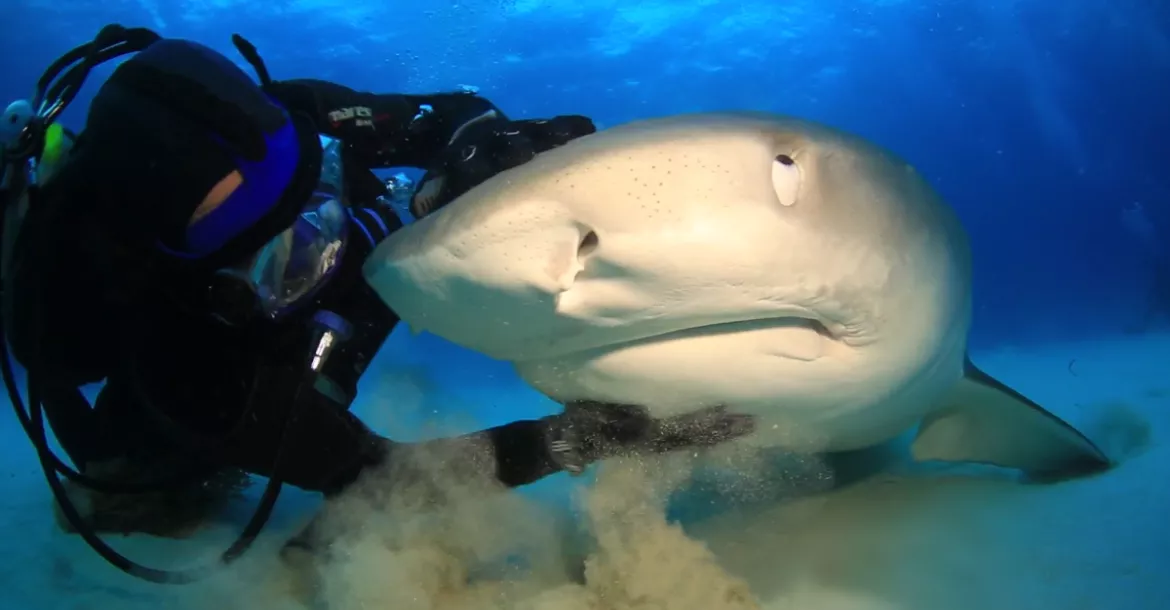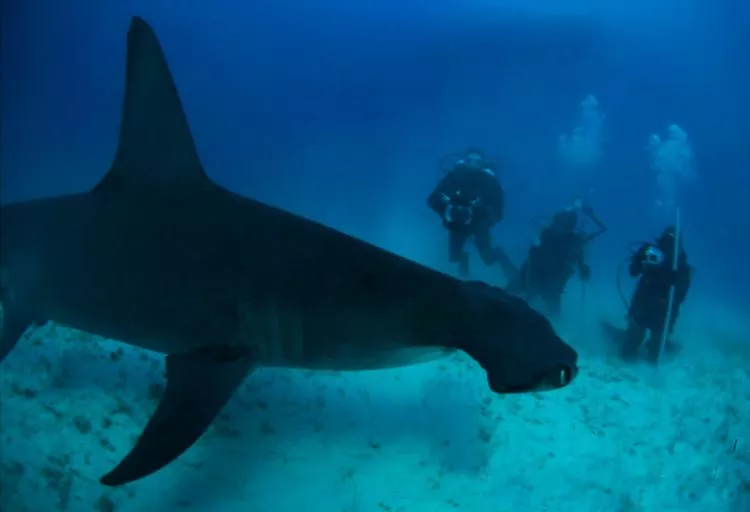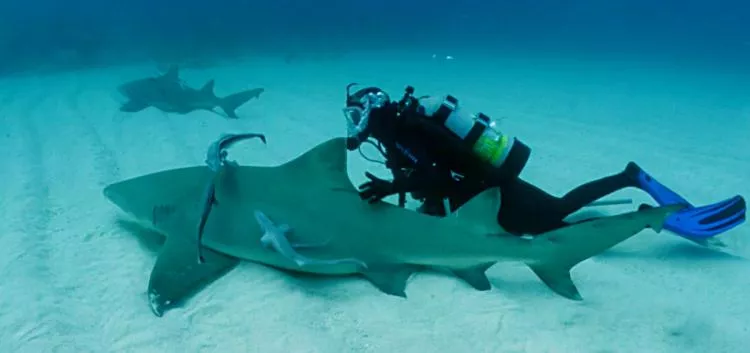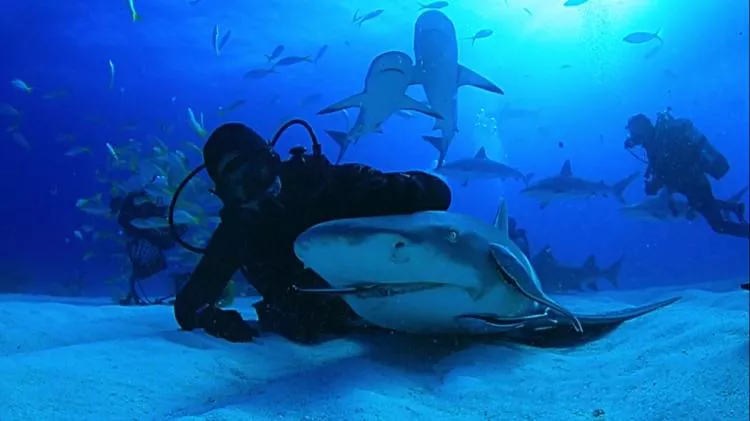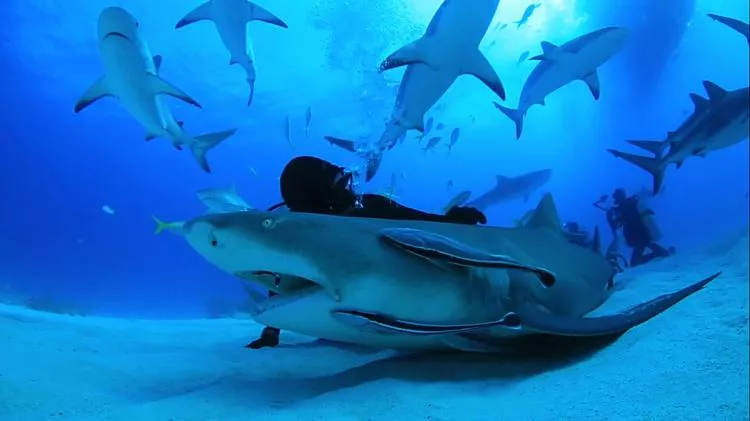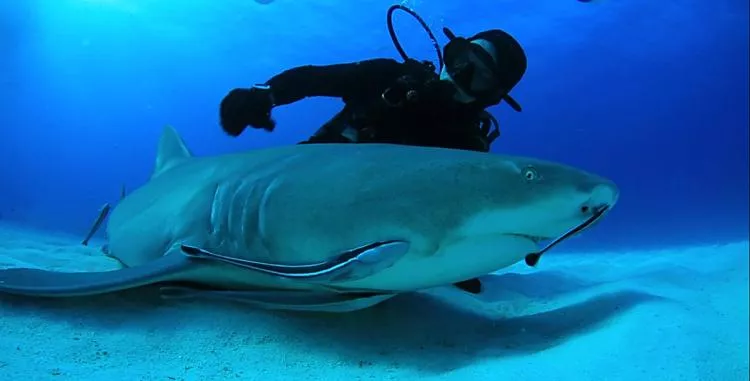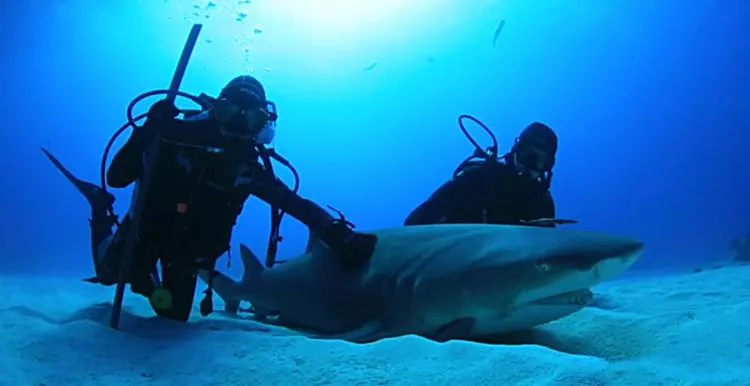A new style of shark dive has been developed by Jim Abernethy, of Scuba Adventures in Florida. In a dramatic demonstration that “shark huggers” are right, all his guests do with the sharks now is to stroke them! Jim was the pioneer who first demonstrated the peaceful way that sharks will interact with divers, especially when their curiosity has been aroused through the offer of a snack. But when he found out that sharks prefer affection to food, he changed his approach.
Contributed by
Factfile
Ila France Porcher, author of The Shark Sessions, is an ethologist who focused on the study of reef sharks after she moved to Tahiti in 1995.
Her observations, which are the first of their kind, have yielded valuable details about their lives, including their reproductive cycle, social biology, population structure, daily behavior patterns, roaming tendencies and cognitive abilities.
Her next book, On the Ethology of Reef Sharks, will soon be released.
These days, Jim offers his guests the opportunity to learn how to befriend a wild shark during their visit to Tiger Beach. Those who accept discover an animal who lies down on the sand at their touch, and seeks them out for more affection whenever they are underwater, for the duration of their visit.
Each week, Jim teaches some of the guests how to approach and begin caressing one of the sharks, and each week, his results progressively improve. He guides the divers to target the lemon sharks and nurse sharks for this activity, but the main focus is on the lemon sharks because they have been considered one of the most dangerous sharks.
The first day goes slowly, because although the sharks are used to him and the crew, they now have to get to know the guests. For this purpose, a lemon shark "cleaning station" is established some distance from the center of the dive site. But, within about two days, the lemon shark begins swimming straight up to the person who is befriending it.
“This is their true nature when they are not feeding,” he said. “It's tremendous.” His guests are so touched by the experience that they often ask for a picture for their wallet, so that they will be able to show off their wild friend who lives on Tiger Beach to friends at home. “Words cannot describe the feelings one can have from such a connection with a wild animal,” Jim declared, “it is so powerful, so moving.”
Shared serenity
His goal for sharks is to “turn fear into love.” In his effort to have his guests appreciate these unusual animals, he has found that it is much more difficult to provide them with a moving moment when the sharks are being fed. In the presence of food, they come in quickly, eat excitedly, and leave, which is more likely to produce an adrenalin rush. In contrast, his videos of divers and sharks lying on the sand together present scenes of remarkable serenity. He wishes that everyone could have this experience of connecting so intimately with a wild creature.
Though they eat little compared with mammals, sharks are usually busy looking for their next meal, and their behavior during feeding dives tends to be dominated by their repeated adoption of the search mode. No shark wants to miss out on a chance to get another scrap, so the lemon sharks especially spend their time searching out bits of food and rushing after each other whenever one is found. Jim found that if no food was in the water, not only did the sharks become calmer, but that all of the species became friendlier to the divers.
Initial contact
The initial contact with the shark is the most difficult, because the shark is afraid. So Jim advises his guests not to sneak up on the animal, but to approach it directly while it is looking at them. The diver is instructed to slowly put down his or her stick and camera, and look at the shark’s eye. The key to success is to look at the shark for 10 to 15 seconds as it comes close, and then very slowly, reach out and touch its head, or anywhere in front of the dorsal fin. The longer the diver is able to maintain contact with the shark during that first encounter, the better are the chances that the animal will react by returning to that diver again. With continued effort, the shark will begin to seek out the diver, swimming in front of him or her, and often actually pausing there, while looking up as if in expectation.
His videos of these encounters show the shark lying on the sand, making an extra effort to pull in water to breathe, while a diver lies beside it, stroking it as if it were a pet. The record so far is 16 and a half minutes, in which two people stroked one lemon shark while the animal lay still on the sea floor. Jim has countless videos showing a guest begin to rub the head or back of a lemon shark, while the shark moves closer to the diver in response.
Old friends
Jim is always surrounded by six or seven lemon sharks, and often strokes more than one at a time, while the tiger sharks sail above. They, too, respond to affection by coming back for more. Jim has a video online showing a tiger named Tarantino reuniting with him after an absence of two years. The shark repeatedly swims up to him to be stroked in an impressive display of the truth of Jim’s assertions. All species of sharks that Jim has encountered treat the divers similarly.
They receive the food he brings at the end of the week. One result of Jim’s new method is that there are no longer any sharks with hooks in them, because they have all been removed. He has counted 91 sharks that have had three or four hooks removed, and this figure is continually climbing. Unfortunately, however, many of the wounds inflicted by fishermen are so horrific that the shark does not survive.
Jim has always targeted the species of sharks with the worst reputations in his efforts to show people their actual behavior, and he takes divers to see hammerhead sharks, tiger sharks, bull sharks, oceanic whitetips, Caribbean reef sharks, nurse sharks and lemon sharks at a variety of sites around the Bahamas. Over the years, he has found that no matter what the species, a natural bond will form between him and certain shark individuals over time.
Their responses to his new dive methods suggest that sharks too appreciate some feelings of bonding with a companion, in spite of the hype and misconceptions that have always plagued them. ■

